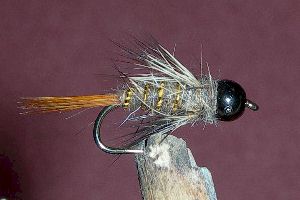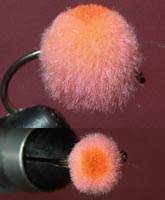How do I fish?
Rods
I generally travel with five 4-pice rods for lines 9, 7, 5, 4, 2 - between nine and seven foot long.
TFO Finesse #2"Lefty Kreh Finesse Rods complement the TFO line by offering a more "traditional" taper and action for those who fish small flies and fine tippets on light lines. These are the ideal rods for meadow streams, limestone creeks, and spring creeks. At short to medium distances, Lefty Kreh Finesse rods cast effortlessly, turning over long leaders easily. The shorter lengths are perfect for tight quarters while the longer length rods will keep a back cast well above tall grasses. Lefty Kreh Finesse rods are handsomely appointed with Rosewood inserts on an up locking reel seat which nicely accentuates the deep olive finish."
Kiwis (New Zealanders refer to themselves as Kiwis, which is also the national /bird/ symbol) seldom use light rods. They seem to go for 8-weight rods. One reason is they fish with quite heavy flies and large strike indicators. Those who use sinking lines (wet-lining) also prefer 8-weight 9-footers.
Lines
Even though I mostly like to use floating lines, I carry a number of different sinking lines. For fishing a streamer just below the surface, I do appreciate the Guidelines TriCast with a transparent intermediate tip. To get down deep with small nymphs, I am currently experimenting with a variety of "homemade" fast-sinking tips.
Flies
Although woolly buggers and egg flies are quite popular among the Kiwis, the majority of their fishing is done with nymphs and dry flies. A guide I was talking to about the size of flies showed my his current box. The biggest fly was size 16 (!). Around stream mouths on Lake Taupo, smelt (nors in Swedish) imitations are popular, and "lumis" seem to do well at night.
You find these flies, and a great selection of other Kiwi flies, at FlyShop NZ
An American, Lee at www.superfly.co.nz, has lived here since the 1980's and sure gets his share of fish always using the same super fast sinking line and a size 8 woolly bugger in the same old pool. I may have convinced him that Lennart Bergqvist's streaking caddis is a good choice for late evening rises.
Wading
During the summer months (December - February), water temperatures may vary between 10 and 22 degrees. Breathable waders are my choice as you can choose your underwear to suit the occasion. Also I like to walk along the river bank to pools that are rarely fished. Please note:
Felt soles are forbidden
The reason is an alga, didymo, which is threatening to spread. If you are planning to come here to fish, also please remember to declare all your fishing gear on arrival. They may want to disinfect your waders and inspect all your "feathers".
Some seemingly small waters, like the gin clear Waitahanui river, can be treacherous. It is a lot more difficult to travel with a heavy wading staff than with half a dozen light carbon fibre rods, so I have to confess that I don't use a staff, but I do take care.
There are a couple of lakes where I'd use a floating tube if I were younger and stronger.
Presenting the fly
To rising fish, I do indeed enjoy trying to present a small dry fly or a big cicada in a free-floating drag-free manner. I won't say I am good at it because I still have an awful lot to learn. I often use a technique casting between 45 degrees across and straight downstream and let the fly drift no more than a metre. I yet have to make out how many casts I make in an hour. Fortunately I have a gym across the street.
For bottom-feeding fish I try the Kiwi way with large strike indicators and heavy "bombs", and I try Czech nymphing. In comparison, presenting a streaking caddis to cruising fish on the lake is a piece of cake.
What about fly fishing in the sea?
There are wonderful opportunities for fly fishing in the sea. Both the west and the east cost are a two-hour drive from Turangi, and it is quite easy to find a small motel or a camp site.
Having access to a boat is a definite advantage, but on any stream mouth or current-swept point, you can cast streamers to feeding fish. Both snapper and kahawai are frequently caught off the beach or a point. Also kingfish and trevally are within reach.
Not my cup of tea.
This is better, but rather without the boat!Contact
You are welcome to email me or call me on my Kiwi cell phone if you want more information.







